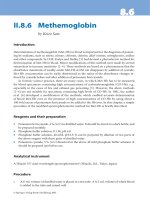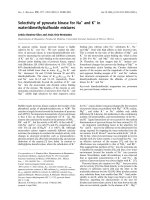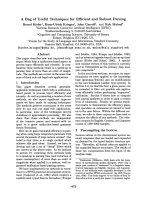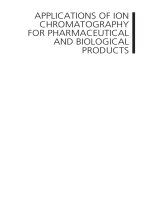Handbook of Deposition Technologies for Films and Coatings-Rointan F.Bunshah
Bạn đang xem bản rút gọn của tài liệu. Xem và tải ngay bản đầy đủ của tài liệu tại đây (30.01 MB, 885 trang )
HANDBOOK OF
DEPOSITION TECHNOLOGIES
FOR FILMS AND COATINGS
Science, Technology
and Applications
Second Edition
Edited by
Rointan F. Bunshah
University of California at Los Angeles
Los Angeles, California
np
NOYES PUBLICATIONS
Park Ridge, New Jersey, U.S.A.
Copyright © 1994 by Noyes Publications
No part of this book may be reproduced or
utilized in any form or by any means, electronic or mechanical, including photocopying,
recording or by any information storage and
retrieval system, without permission in writing
from the Publisher.
Library of Congress Catalog Card Number: 93-30751
ISBN: 0-8155-1337-2
Printed in the United States
Published in the United States of America by
Noyes Publications
Mill Road, Park Ridge, New Jersey 07656
10 9 8 7 6 5 4 3 2 1
Library of Congress Cataloging-in-Publication Data
Handbook of deposition technologies for films and coatings /
edited by Rointan F. Bunshah. -- 2nd ed.
p. cm.
Rev. ed of: Deposition technologies for films and coatings.
c1982.
Includes bibliographical references and index.
ISBN 0-8155-1337-2
1. Coating processes.
I. Bunshah, R. F. (Rointan
Framroze)
II. Title: Deposition technologies for films and coatings.
TP156.C57H38
1994
667' .9--dc20
9 3 -30751
CIP
DEDICATION
This volume is dedicated to Professor John
Thornton for his many pioneering contributions to thin
film science and technology which have inspired so
many of the scientists and engineers working in this field.
vii
MATERIALS SCIENCE AND PROCESS TECHNOLOGY SERIES
Editors
Rointan F. Bunshah, University of California, Los Angeles (Series Editor)
Gary E. McGuire, Microelectronics Center of North Carolina (Series Editor)
Stephen M. Rossnagel, IBM Thomas J. Watson Research Center
(Consulting Editor)
Electronic Materials and Process Technology
HANDBOOK OF DEPOSITION TECHNOLOGIES FOR FILMS AND COATINGS, Second
Edition: edited by Rointan F. Bunshah
CHEMICAL VAPOR DEPOSITION FOR MICROELECTRONICS: by Arthur Sherman
SEMICONDUCTOR MATERIALS AND PROCESS TECHNOLOGY HANDBOOK: edited by
Gary E. McGuire
HYBRID MICROCIRCUIT TECHNOLOGY HANDBOOK: by James J. Licari and Leonard R.
Enlow
HANDBOOK OF THIN FILM DEPOSITION PROCESSES AND TECHNIQUES: edited by Klaus
K. Schuegraf
IONIZED-CLUSTER BEAM DEPOSITION AND EPITAXY: by Toshinori Takagi
DIFFUSION PHENOMENA IN THIN FILMS AND MICROELECTRONIC MATERIALS: edited by
Devendra Gupta and Paul S. Ho
HANDBOOK OF CONTAMINATION CONTROL IN MICROELECTRONICS: edited by Donald
L. Tolliver
HANDBOOK OF ION BEAM PROCESSING TECHNOLOGY: edited by Jerome J. Cuomo,
Stephen M. Rossnagel, and Harold R. Kaufman
CHARACTERIZATION OF SEMICONDUCTOR MATERIALS, Volume 1: edited by Gary E.
McGuire
HANDBOOK OF PLASMA PROCESSING TECHNOLOGY: edited by Stephen M. Rossnagel,
Jerome J. Cuomo, and William D. Westwood
HANDBOOK OF SEMICONDUCTOR SILICON TECHNOLOGY: edited by William C. O’Mara,
Robert B. Herring, and Lee P. Hunt
HANDBOOK OF POLYMER COATINGS FOR ELECTRONICS, 2nd Edition: by James Licari
and Laura A. Hughes
HANDBOOK OF SPUTTER DEPOSITION TECHNOLOGY: by Kiyotaka Wasa and Shigeru
Hayakawa
HANDBOOK OF VLSI MICROLITHOGRAPHY: edited by William B. Glendinning and John
N. Helbert
CHEMISTRY OF SUPERCONDUCTOR MATERIALS: edited by Terrell A. Vanderah
CHEMICAL VAPOR DEPOSITION OF TUNGSTEN AND TUNGSTEN SILICIDES: by John E.
J. Schmitz
ELECTROCHEMISTRY OF SEMICONDUCTORS AND ELECTRONICS: edited by John McHardy
and Frank Ludwig
v
vi
Contents
Series
HANDBOOK OF CHEMICAL VAPOR DEPOSITION: by Hugh O. Pierson
DIAMOND FILMS AND COATINGS: edited by Robert F. Davis
ELECTRODEPOSITION: by Jack W. Dini
HANDBOOK OF SEMICONDUCTOR WAFER CLEANING TECHNOLOGY: edited by Werner
Kern
CONTACTS TO SEMICONDUCTORS: edited by Leonard J. Brillson
HANDBOOK OF MULTILEVEL METALLIZATION FOR INTEGRATED CIRCUITS: edited by
Syd R. Wilson, Clarence J. Tracy, and John L. Freeman, Jr.
HANDBOOK OF CARBON, GRAPHITE, DIAMONDS AND FULLERENES: by Hugh O. Pierson
Ceramic and Other Materials—Processing and Technology
SOL-GEL TECHNOLOGY FOR THIN FILMS, FIBERS, PREFORMS, ELECTRONICS AND
SPECIALTY SHAPES: edited by Lisa C. Klein
FIBER REINFORCED CERAMIC COMPOSITES: edited by K. S. Mazdiyasni
ADVANCED CERAMIC PROCESSING AND TECHNOLOGY, Volume 1: edited by Jon G. P.
Binner
FRICTION AND WEAR TRANSITIONS OF MATERIALS: by Peter J. Blau
SHOCK WAVES FOR INDUSTRIAL APPLICATIONS: edited by Lawrence E. Murr
SPECIAL MELTING AND PROCESSING TECHNOLOGIES: edited by G. K. Bhat
CORROSION OF GLASS, CERAMICS AND CERAMIC SUPERCONDUCTORS: edited by
David E. Clark and Bruce K. Zoitos
HANDBOOK OF INDUSTRIAL REFRACTORIES TECHNOLOGY: by Stephen C. Carniglia
and Gordon L. Barna
CERAMIC FILMS AND COATINGS: edited by John B. Wachtman and Richard A. Haber
Related Titles
ADHESIVES TECHNOLOGY HANDBOOK: by Arthur H. Landrock
HANDBOOK OF THERMOSET PLASTICS: edited by Sidney H. Goodman
SURFACE PREPARATION TECHNIQUES FOR ADHESIVE BONDING: by Raymond F.
Wegman
FORMULATING PLASTICS AND ELASTOMERS BY COMPUTER: by Ralph D. Hermansen
HANDBOOK OF ADHESIVE BONDED STRUCTURAL REPAIR: by Raymond F. Wegman and
Thomas R. Tullos
CARBON–CARBON MATERIALS AND COMPOSITES: edited by John D. Buckley and Dan
D. Edie
CODE COMPLIANCE FOR ADVANCED TECHNOLOGY FACILITIES: by William R. Acorn
Contributors
Rointan F. Bunshah
Department of Materials Science and
Engineering
University of California at Los Angeles
Los Angeles, California
Jan-Otto Carlsson
Department of Chemistry
Upsala University
Upsala, Sweden
Joseph E. Greene
Coordinated Science Laboratory
University of Illinois at UrbanaChampaign
Urbana, Illinois
Bret L. Halpern
Jet Process Corporation
New Haven, Connecticut
Donald M. Mattox
Society of Vacuum Coaters
Albuquerque, New Mexico
Gary E. McGuire
Microelectronics Center of North
Carolina
Research Triangle Park, North Carolina
Jerome C. Schmitt
Jet Process Corporation
New Haven, Connecticut
Morton Schwartz
Electrochemical/Metal Finishing
Consultant
Los Angeles, California
Arthur Sherman
Consultant
Palo Alto, California
xiii
xiv
Contents
Contributors
John A. Thornton*
Coordinated Science Laboratory
University of Illinois at UrbanaChampaign
Urbana, Illinois
*
Robert C. Tucker, Jr.
Praxair Surface Technologies, Inc.
Indianapolis, Indiana
Professor Thornton died unexpectedly in
November, 1987.
NOTICE
To the best of our knowledge the information in this publication is
accurate; however the Publisher does not assume any responsibility
or liability for the accuracy or completeness of, or consequences
arising from, such information. This book is intended for informational
purposes only. Mention of trade names or commercial products does
not constitute endorsement or recommendation for use by the Publisher.
Final determination of the suitability of any information or product
for use contemplated by any user, and the manner of that use, is the
sole responsibility of the user. We recommend that anyone intending
to rely on any recommendation of materials or procedures mentioned
in this publication should satisfy himself as to such suitability, and
that he can meet all applicable safety and health standards.
Preface to the Second Edition
A decade after the first edition of this volume was published, a second
edition is being brought out partly due to the excellent response to the first
edition and also to update the many improvements in deposition technologies,
the mechanisms and applications.
The entire volume has been extensively revised and contains 50% or
more new material. Five entirely new chapters have been added. The
organization of the book has also been changed in the following respects:
1. Considerably more material has been added in Plasma
Assisted Vapor Deposition Processes.
2. A new chapter on Metallurgical Coating Applications has
been added.
The chapter in the first edition on Polymeric Coating techniques has
been omitted as it deserves a volume by itself. Large topics such as coatings
technology in microelectronics, diamond films, etc., have been treated in
separate volumes in this series.
Although there are some new competing volumes dealing with selected
topics on the materials science of thin films, this volume remains the only
comprehensive treatment of the entire subject of Deposition Technology.
Applications of films and coatings spans the entire gamut of science and
technology. Generic application areas include electronic, magnetic, optical,
mechanical, chemical and decorative applications. New deposition technologies such as arc evaporation, unbalanced magnetron sputtering, ion beam
assisted deposition, and metal-organic CVD have come on stream for critical
applications. In this post cold war era, many economic solutions to
engineering problems will necessarily involve coatings, e.g., battery materials
for the emerging electric car industry.
ix
x
Preface
Contents
The core subjects are the basic technologies for the deposition of films
and coatings. These are the Physical Vapor Deposition (PVD) Processes
consisting of Evaporation, Sputtering, and Ion Plating; Chemical Vapor
Deposition (CVD) and Plasma-Assisted Chemical Vapor Deposition (PACVD);
Electrodeposition and Electroless Plating; Thermal Spraying, Plasma Spraying and Detonation Gun Technologies. Chapters on other subjects common
to the above technologies are included. These are: Adhesion of Coatings,
Cleaning of Substrates, Role of Plasmas in Deposition Processes, Structure
of PVD Deposits, Growth and Structure of PVD Films, Mechanical and
Tribological Properties of PVD Deposits, Elemental and Structural Characterization Techniques, and Metallurgical Coatings. A relatively new development, Jet Vapor Deposition Process, was added as the last chapter in the
book during the page proof stage because of its novelty.
We hope that this volume will be useful to the multitude of disciplines
represented by the workers in this field and provide a source for future
developments.
University of California
Los Angeles, California
June, 1993
Rointan F. Bunshah
Preface to the First Edition
Almost universally in high technology applications, a composite material
is used where the properties of the surface are intentionally different from those
of the core. Thus, materials with surface coatings are used in the entire crosssection of applications ranging from microelectronics, display devices, chemical corrosion, tribology including cutting tools, high temperature oxidation/
corrosion, solar cells, thermal insulation and decorative coatings (including
toys, automobile components, watch cases, etc.).
A large variety of materials is used to produce these coatings. They are
metals, alloys, refractory compounds (e.g., oxides, nitrides, carbides),
intermetallic compounds (e.g., GaAg) and polymers in single or multiple
layers. The thickness of the coatings ranges from a few atom layers to millions
of atom layers. The microstructure and hence the properties of the coatings
can be varied widely and at will, thus permitting one to design new material
systems with unique properties. (A material system is defined as the
combination of the substrate and coating.)
Historically, coating technology evolved and developed in the last 30
years in several industries, i.e., decorative coatings, microelectronics and
metallurgical coatings. They used similar techniques but only with the
passage of time have the various approaches reached a common frontier
resulting in much useful cross-fertilization. That very vital process is
proceeding ever more strongly at this time.
With this background in mind, a short course on Deposition Technologies and their applications was developed and given on five consecutive
occasions in the last three years. This volume is based on the material used
in the course.
xi
xii
It comprises chapters dealing with the various coating techniques, the
resulting microstructure, properties and applications. The specific techniques
covered are evaporation, ion plating, sputtering, chemical vapor deposition,
electrodeposition from aqueous solution, plasma and detonation gun coating
techniques, and polymeric coatings. In addition several other chapters are
added. Plasmas are used in many of the deposition processes and therefore
a special chapter on this topic has been added. Cleaning of the substrate and
the related topic of adhesion of the coating are common to many processes
and a brief exposé of this topic is presented. Characterization of the films, i.e.,
composition, impurities, crystal structure and microstructure are essential to
the understanding of the various processes. Two chapters dealing with this
area are included. Finally, a chapter on application of deposition techniques
in microelectronics is added to give one example of the use of several of these
techniques in a specific area. This volume represents a unique collection of
our knowledge on Deposition Technologies and their applications up to and
including the state-of-the-art. It is hoped that it will be very useful to students,
practicing engineers and managerial personnel who have to learn about this
essential area of modern technology.
University of California
Los Angeles, California
April 1982
R. F. Bunshah
Contents
xv
Contents
1
Deposition Technologies: An Overview ....................... 27
Rointan F. Bunshah
1.0
2.0
3.0
4.0
5.0
THE MARKET .............................................................................. 27
INTRODUCTION ........................................................................... 28
AIM AND SCOPE ......................................................................... 30
DEFINITIONS AND CONCEPTS ................................................... 31
PHYSICAL VAPOR DEPOSITION (PVD) PROCESS
TERMINOLOGY ........................................................................... 32
6.0 CLASSIFICATION OF COATING PROCESSES ........................... 34
7.0 GAS JET DEPOSITION WITH NANO-PARTICLES ....................... 36
8.0 MICROSTRUCTURE AND PROPERTIES ..................................... 38
9.0 UNIQUE FEATURES OF DEPOSITED MATERIALS AND GAPS
IN UNDERSTANDING ................................................................... 40
10.0 CURRENT APPLICATIONS .......................................................... 41
10.1 Decorative/Functional Coating ............................................. 41
10.2 High Temperature Corrosion ................................................ 42
10.3 Environmental Corrosion ..................................................... 42
10.4 Friction and Wear ............................................................... 42
10.5 Materials Conservation ........................................................ 43
10.6 Cutting Tools ...................................................................... 43
10.7 Nuclear Fuels ..................................................................... 44
10.8 Biomedical Uses ................................................................. 44
xv
xvi
Contents
10.9 Electrical Uses ................................................................... 44
11.0 “FRONTIER AREAS” FOR THE APPLICATION OF
THE PRODUCTS OF DEPOSITION TECHNOLOGY ..................... 44
12.0 SELECTION CRITERIA ................................................................. 46
13.0 SUMMARY ................................................................................... 48
APPENDIX 1: DEPOSITION PROCESS DEFINITIONS........................... 49
Conduction and Diffusion Processes............................................. 49
Chemical processes ..................................................................... 50
Wetting Process........................................................................... 50
Spraying Processes ..................................................................... 51
REFERENCES ...................................................................................... 54
2
Plasmas in Deposition Processes .............................. 55
John A. Thornton and Joseph E. Greene
1.0
2.0
INTRODUCTION ........................................................................... 55
PARTICLE MOTION ..................................................................... 56
2.1 Mean Free Path and Collision Cross Sections .................... 56
2.2 Free Electron Kinetic Energy in a Plasma........................... 58
2.3 Electron Energy Distribution Functions ............................... 59
2.4 Collision Frequencies .......................................................... 61
3.0 COLLECTIVE PHENOMENA ........................................................ 68
3.1 Plasma Sheaths ................................................................. 69
3.2 Ambipolar Diffusion ............................................................. 74
3.3 Plasma Oscillations ............................................................ 75
4.0 PLASMA DISCHARGES .............................................................. 76
4.1 Introduction ......................................................................... 76
4.2 Ionization Balances and the Paschen Relation .................... 77
4.3 Cold Cathode Discharges ................................................... 82
4.4 Magnetron Discharges ........................................................ 84
4.5 RF Discharges .................................................................... 85
5.0 PLASMA VOLUME REACTIONS ................................................. 87
5.1 Introduction ......................................................................... 87
5.2 Electron/Atom Interactions .................................................. 87
5.3 Electron/Molecule Interactions ............................................ 88
5.4 Metastable Species ............................................................ 90
5.5 Applications of Volume Reactions....................................... 92
6.0 SURFACE REACTIONS ............................................................... 93
6.1 Introduction ......................................................................... 93
6.2 Ion Bombardment ................................................................ 93
6.3 Electron Bombardment ..................................................... 100
6.4 Glow Discharge Surface Cleaning and Activation .............. 100
REFERENCES .................................................................................... 103
Contents
3
xvii
Surface Preparation for Film and Coating Deposition
Processes ................................................................ 108
Donald M. Mattox
1.0
2.0
INTRODUCTION ......................................................................... 108
CONTAMINATION ...................................................................... 110
2.1 Recontamination ............................................................... 111
3.0 ENVIRONMENT CONTROL ........................................................ 113
4.0 CLEANING PROCESSES .......................................................... 119
4.1 Particulate Removal .......................................................... 120
4.2 Abrasive Cleaning ............................................................. 121
4.3 Etch Cleaning ................................................................... 121
4.4 Fluxing .............................................................................. 122
4.5 Alkaline Cleaners .............................................................. 122
4.6 Detergent Cleaning ........................................................... 122
4.7 Chelating Agents .............................................................. 123
4.8 Solvent Cleaning ............................................................... 123
4.9 Oxidation Cleaning............................................................ 128
4.10 Volatilization Cleaning....................................................... 130
4.11 Hydrogen Reduction Cleaning ........................................... 130
4.12 Electrolytic Cleaning ......................................................... 131
5.0 DRYING AND OUTGASSING ..................................................... 132
6.0 MONITORING OF CLEANING .................................................... 133
7.0 IN SITU CLEANING .................................................................... 134
7.1 Ion Scrubbing .................................................................... 134
8.0 PLASMAS .................................................................................. 134
8.1 Generation of Plasmas ..................................................... 135
8.2 Plasma Chemistry ............................................................ 140
8.3 Bombardment Effects on Surfaces .................................... 141
8.4 Sputter Cleaning and Etching............................................ 143
9.0 STORAGE AND HANDLING ....................................................... 147
10.0 ACTIVATION AND SENSITIZATION ............................................ 148
11.0 SURFACE MODIFICATION ........................................................ 150
12.0 PASSIVATION AND PRESERVATION ....................................... 151
13.0 SAFETY ..................................................................................... 152
REFERENCES .................................................................................... 152
4
Evaporation: Processes, Bulk Microstructures and
Mechanical Properties .............................................. 157
Rointan F. Bunshah
1.0
2.0
GENERAL INTRODUCTION ........................................................ 157
SCOPE ...................................................................................... 159
xviii
3.0
Contents
PVD PROCESSES .................................................................... 159
3.1 Preamble .......................................................................... 159
3.2 PVD Processes ................................................................ 160
3.3 Advantages and Limitations .............................................. 165
4.0 THEORY AND MECHANISMS ................................................... 166
4.1 Vacuum Evaporation ......................................................... 166
5.0 EVAPORATION PROCESS AND APPARATUS ......................... 169
5.1 The System ...................................................................... 169
6.0 EVAPORATION SOURCES ....................................................... 172
6.1 General Considerations ..................................................... 172
6.2 Resistance Heated Sources ............................................. 175
6.3 Sublimation Sources ......................................................... 176
6.4 Evaporation Source Materials............................................ 178
6.5 Induction Heated Sources ................................................. 180
6.6 Electron Beam Heated Sources ........................................ 181
6.7 Arc Evaporation ................................................................ 189
7.0 LASER INDUCED EVAPORATION/LASER ABLATION/PULSED
LASER DEPOSITION (PLD) ....................................................... 192
8.0 DEPOSITION RATE MONITORS AND PROCESS CONTROL .... 194
8.1 Monitoring of the Vapor Stream ......................................... 194
8.2 Monitoring of Deposited Mass ........................................... 196
8.3 Monitoring of Specific Film Properties ............................... 196
8.4 Evaporation Process Control ............................................. 199
9.0 DEPOSITION OF VARIOUS MATERIALS .................................. 201
9.1 Deposition of Metals and Elemental Semiconductors ........ 201
9.2 Deposition of Alloys .......................................................... 201
9.3 Deposition of Intermetallic Compounds ............................. 205
9.4 Deposition of Refractory Compounds ................................ 209
9.5 Reactive Evaporation Process ........................................... 213
9.6 Activated Reactive Evaporation (ARE) ............................... 213
9.7 Materials Synthesized by Evaporation-based Processes .. 223
10.0 MICROSTRUCTURE OF PVD CONDENSATES ......................... 224
10.1 Microstructure Evolution .................................................... 224
10.2 Texture ............................................................................. 236
10.3 Residual Stresses ............................................................ 237
10.4 Defects ............................................................................. 237
11.0 PHYSICAL PROPERTIES OF THIN FILMS ................................ 241
12.0 MECHANICAL AND RELATED PROPERTIES ............................ 241
12.1 Mechanical Properties ................................................................ 241
13.0 PURIFICATION OF METALS BY EVAPORATION ...................... 256
APPENDIX ......................................................................................... 258
On Progress in Scientific Investigations in the Field of Vacuum
Evaporation in the Soviet Union................................................... 258
REFERENCES .................................................................................... 261
Contents
5
xix
Sputter Deposition Processes .................................. 275
John A. Thornton and Joseph E. Greene
1.0
INTRODUCTION ......................................................................... 275
1.1 Sputter Deposition Systems ............................................. 278
1.2 Sputter-Deposition Applications ........................................ 279
1.3 Process Implementation ................................................... 282
1.4 History of Sputter Deposition and Background Reading .... 283
2.0 SPUTTERING MECHANISMS .................................................... 284
2.1 Sputtering Rate ................................................................. 285
2.2 Momentum Exchange ....................................................... 289
2.3 Alloys and Compounds ..................................................... 292
2.4 Sputtering with Reactive Species ...................................... 295
2.5 The Nature of Sputtered Species ...................................... 296
2.6 Energy Distribution of Sputtered Species .......................... 298
3.0 SPUTTER DEPOSITION TECHNIQUES ..................................... 301
3.1 Planar Diode and the DC Glow Discharge ......................... 301
3.2 Triode Discharge Devices .................................................. 305
3.3 Magnetrons ....................................................................... 306
3.4 RF Sputtering ................................................................... 318
3.5 Ion-Beam Sputtering ......................................................... 327
4.0 SPUTTER DEPOSITION MODES ............................................... 328
4.1 Reactive Sputtering ........................................................... 328
4.2 Bias Sputtering ................................................................. 332
REFERENCES .................................................................................... 337
6
Ion Plating ................................................................. 346
Donald M. Mattox
1.0
2.0
3.0
4.0
5.0
INTRODUCTION ......................................................................... 346
PROCESSING PLASMA ............................................................ 351
GENERATION OF PLASMAS .................................................... 351
3.1 DC Diode Discharge.......................................................... 351
3.2 RF Discharge .................................................................... 355
3.3 Microwave Discharges ...................................................... 356
3.4 Electron Emitter Discharge ............................................... 356
3.5 Magnetron Discharges ...................................................... 357
3.6 Plasma Enhancement ....................................................... 358
PLASMA CHEMISTRY ............................................................... 359
BOMBARDMENT EFFECTS ON SURFACES ............................ 360
5.1 Collisional Effects ............................................................. 363
5.2 Surface Region Effects ..................................................... 368
5.3 Near Surface Region Effects ............................................. 369
5.4 Bulk Effects ...................................................................... 369
xx
Contents
6.0
SOURCES OF DEPOSITING ATOMS ........................................ 369
6.1 Thermal Vaporization ........................................................ 370
6.2 Sputtering ......................................................................... 371
6.3 Vacuum Arcs .................................................................... 371
6.4 Chemical Vapor Precursors .............................................. 373
7.0 REACTIVE ION PLATING ........................................................... 373
8.0 BOMBARDMENT EFFECTS ON FILM PROPERTIES ................ 373
8.1 Effects: Adatom Nucleation............................................... 373
8.2 Effects: Interface Formation .............................................. 374
8.3 Effects: Film Growth ......................................................... 374
8.4 Film Adhesion................................................................... 376
8.5 Film Morphology/Density .................................................. 376
8.6 Residual Film Stress ........................................................ 378
8.7 Crystallographic Orientation .............................................. 378
8.8 Gas Incorporation .............................................................. 380
8.9 Surface Coverage .............................................................. 380
8.10 Other Properties ............................................................... 381
9.0 ION PLATING SYSTEM REQUIREMENTS ................................. 381
9.1 Vacuum System ............................................................... 381
9.2 High Voltage Components ................................................ 381
9.3 Gas Handling System ....................................................... 383
9.4 Evaporation/Sublimation Sources ...................................... 383
9.5 Sputtering Sources ........................................................... 383
9.6 Plasma Uniformity ............................................................ 384
9.7 Plasma Generation Near the Substrate Surface ................ 384
9.8 Substrate Fixturing ........................................................... 384
10.0 PROCESS MONITORING AND CONTROL ................................. 385
10.1 Plasma ............................................................................. 385
10.2 Substrate Temperature ..................................................... 385
10.3 Specifications ................................................................... 385
11.0 PROBLEM AREAS .................................................................... 386
12.0 APPLICATIONS.......................................................................... 389
13.0 SUMMARY ................................................................................. 389
REFERENCES .................................................................................... 391
7
Chemical Vapor Deposition ...................................... 400
Jan-Otto Carlsson
1.0
2.0
3.0
INTRODUCTION ......................................................................... 400
IMPORTANT REACTION ZONES IN CVD ................................... 401
DESIGN OF CVD EXPERIMENTS .............................................. 402
3.1 Classification of CVD Reactions........................................ 403
3.2 Thermodynamics .............................................................. 405
3.3 Adhesion .......................................................................... 409
Contents
xxi
3.4 Substrate Cleaning Procedures ......................................... 410
3.5 The CVD system .............................................................. 410
3.6 The Gas Dispensing System ............................................ 411
3.7 The Reactor ...................................................................... 413
3.8 The Exhaust System ........................................................ 415
3.9 Analysis of the Vapor in a CVD Reactor............................ 417
4.0 GAS FLOW DYNAMICS ............................................................ 417
4.1 Gas Flow Patterns ............................................................ 420
4.2 Boundary Layers ............................................................... 423
4.3 Mass Transport Processes Across a Boundary Layer ....... 428
5.0 RATE-LIMITING STEPS DURING CVD ....................................... 428
6.0 REACTION MECHANISMS ........................................................ 436
7.0 NUCLEATION ............................................................................. 438
8.0 SURFACE MORPHOLOGY AND MICROSTRUCTURE OF CVD
MATERIALS ............................................................................... 442
9.0 SELECTIVE DEPOSITION .......................................................... 445
9.1 Area-Selective Growth ....................................................... 446
9.2 Phase-Selective Deposition ............................................... 452
10.0 SOME APPLICATIONS OF THE CVD TECHNIQUE ................... 453
11.0 OUTLOOK .................................................................................. 455
REFERENCES .................................................................................... 456
8
Plasma-Enhanced Chemical Vapor Deposition ........ 460
Arthur Sherman
INTRODUCTION ......................................................................... 460
REACTOR INFLUENCE ON PLASMA BEHAVIOR ..................... 461
2.1 DC/AC Glow Discharges ................................................... 461
2.2 AC Discharges with Unequal Area Electrodes ................... 464
2.3 Frequency Effects on RF Plasma Reactor Behavior .......... 466
2.4 Adjusting DC Bias for Fixed Electrode Geometry .............. 467
2.5 Plasma-Enhanced CVD (PECVD) Reactors ...................... 467
3.0 FILMS DEPOSITED BY CVD ..................................................... 472
3.1 Silicon Nitride ................................................................... 472
3.2 Silicon Dioxide .................................................................. 478
3.3 Conducting Films .............................................................. 481
REFERENCES .................................................................................... 482
1.0
2.0
9
Plasma-Assisted Vapor Deposition Processes:
Overview ................................................................... 485
Rointan F. Bunshah
1.0
2.0
3.0
INTRODUCTION ......................................................................... 485
PLASMA-ASSISTED DEPOSITION PROCESSES ..................... 488
MODEL OF A DEPOSITION PROCESS..................................... 488
xxii
Contents
4.0
MATERIALS DEPOSITED BY REACTIVE VAPOR DEPOSITION
PROCESSES ............................................................................. 491
5.0 KEY ISSUES IN PLASMA-ASSISTED REACTIVE VAPOR
DEPOSITION PROCESSES....................................................... 492
5.1 Plasma Volume Chemistry ............................................... 492
5.2 Type and Nature of the Bombardment of the Growing Film 493
6.0 PLASMA-ASSISTED DEPOSITION TECHNIQUES IN CURRENT
USAGE ...................................................................................... 495
6.1 Plasma-Assisted Chemical Vapor Deposition ................... 495
6.2 Sputter Deposition ............................................................ 496
6.3 Activated Reactive Evaporation (ARE) ............................... 497
7.0 LIMITATIONS OF CURRENT PLASMA-ASSISTED TECHNIQUES
499
8.0 HYBRID PROCESSES ............................................................... 501
9.0 CONCLUSIONS .......................................................................... 501
REFERENCES .................................................................................... 505
10
Deposition from Aqueous Solutions: An Overview ..... 506
Morton Schwartz
1.0
2.0
3.0
INTRODUCTION ......................................................................... 506
GENERAL PRINCIPLES ............................................................ 508
ELECTRODEPOSITION.............................................................. 520
3.1 Mechanism of Deposition .................................................. 520
3.2 Parameters ....................................................................... 526
4.0 PROCESSING TECHNIQUES .................................................... 536
5.0 SELECTION OF DEPOSIT ......................................................... 539
5.1 Individual Metals ............................................................... 539
5.2 Alloy Deposition ................................................................ 543
6.0 SELECTED SPECIAL PROCESSES ......................................... 550
6.1 Electroless Deposition ...................................................... 550
6.2 Electroforming................................................................... 557
6.3 Anodizing .......................................................................... 560
6.4 Plating on Plastics............................................................ 570
6.5 Plating Printed Circuit Boards ........................................... 571
7.0 STRUCTURES AND PROPERTIES OF DEPOSITS ................... 574
8.0 SUMMARY ................................................................................. 596
APPENDIX A - Preparation of Substrates for Electroplating .................. 597
APPENDIX B - Representative Electroless Plating
Solution Formulation .................................................... 599
APPENDIX C - Comparison of Aluminum Anodizing Processes
(Types I, II and III) ......................................................... 602
REFERENCES .................................................................................... 605
Contents
11
xxiii
Advanced Thermal Spray Deposition Techniques ..... 617
Robert C. Tucker, Jr.
1.0
2.0
INTRODUCTION ......................................................................... 617
EQUIPMENT AND PROCESSES ............................................... 618
2.1 Plasma Spray Process ..................................................... 618
2.2 Detonation Gun Deposition Process ................................. 626
2.3 High Velocity Oxy-Fuel Deposition.................................... 628
2.4 Thermal Control ................................................................ 629
2.5 Auxiliary Equipment .......................................................... 630
2.6 Equipment-Related Coating Limitations............................. 631
3.0 TOTAL COATING PROCESS ..................................................... 632
3.1 Powder ............................................................................. 632
3.2 Substrate Preparation ....................................................... 632
3.3 Masking ............................................................................ 633
3.4 Coating ............................................................................. 633
3.5 Finishing ........................................................................... 635
4.0 COATING STRUCTURE AND PROPERTIES .............................. 636
4.1 Surface Macrostructure and Microstructure ....................... 636
4.2 Microstructure................................................................... 637
4.3 Bond Strength ................................................................... 643
4.4 Residual Stress ................................................................ 644
4.5 Density ............................................................................. 645
4.6 Mechanical Properties ...................................................... 647
4.7 Wear and Friction ............................................................. 653
4.8 Corrosion Properties ......................................................... 660
4.9 Thermal Properties ............................................................ 662
4.10 Electrical Characteristics .................................................. 664
5.0 SUMMARY ................................................................................. 665
REFERENCES .................................................................................... 665
12
Non-Elemental Characterization of Films
and Coatings ............................................................ 669
Donald M. Mattox
1.0
2.0
3.0
4.0
5.0
INTRODUCTION ......................................................................... 669
CHARACTERIZATION ................................................................ 671
FILM FORMATION ..................................................................... 677
ELEMENTAL AND STRUCTURAL ANALYSIS ............................ 681
SOME PROPERTY MEASUREMENTS ..................................... 682
5.1 Adhesion .......................................................................... 682
5.2 Film Thickness ................................................................. 689
5.3 Film Stress ....................................................................... 691
5.4 Coefficient of Thermal Expansion ...................................... 695
xxiv
Contents
5.5 Mechanical Properties ...................................................... 695
5.6 Electrical Resistivity.......................................................... 696
5.7 Temperature Coefficient of Resistivity (TCR) ...................... 696
5.8 Electromigration ................................................................ 697
5.9 Density ............................................................................. 697
5.10 Porosity ............................................................................ 698
5.11 Chemical Etch Rate (Dissolution) ..................................... 701
6.0 SUMMARY ................................................................................. 701
REFERENCES .................................................................................... 702
13
Nucleation, Film Growth, and Microstructural
Evolution ................................................................... 707
Joseph E. Greene
1.0
2.0
INTRODUCTION ......................................................................... 707
NUCLEATION AND THE EARLY STAGES OF FILM GROWTH.. 708
2.1 Three-Dimensional Nucleation and Growth ........................ 710
2.2 Two-Dimensional Nucleation and Growth .......................... 721
2.3 Stranski-Krastanov Nucleation and Growth ....................... 728
3.0 COMPUTER SIMULATIONS OF MICROSTRUCTURE
EVOLUTION ............................................................................... 730
3.1 Film Growth in the Ballistic Aggregation, Low-Adatom
Mobility, Limit ................................................................... 732
3.2 Effects of Adatom Migration .............................................. 734
4.0 MICROSTRUCTURE EVOLUTION AND STRUCTURE-ZONE...... 736
5.0 EFFECTS OF LOW-ENERGY ION IRRADIATION DURING FILM
GROWTH ................................................................................... 743
5.1 Effects of Low-Energy Ion/Surface Interactions
on Nucleation Kinetics ...................................................... 743
5.2 Effects of Low-Energy Ion/Surface Interactions
on Film Growth Kinetics.................................................... 750
REFERENCES .................................................................................... 760
14
Metallurgical Applications.......................................... 766
Rointan F. Bunshah
1.0
2.0
3.0
4.0
5.0
6.0
INTRODUCTION ......................................................................... 766
CORROSION .............................................................................. 766
GALVANIC CORROSION ........................................................... 767
3.1 Galvanic Cells ................................................................... 768
EMF AND GALVANIC SERIES .................................................. 770
COATINGS FOR GALVANIC CORROSION ................................ 770
METHODS OF DEPOSITION OF METALLIC COATINGS ........... 772
Contents
xxv
7.0
EXAMPLES OF CORROSION-RESISTANT COATINGS ............. 773
7.1 Preamble .......................................................................... 773
8.0 HIGH TEMPERATURE OXIDATION/CORROSION ...................... 776
9.0 FRICTION AND WEAR ............................................................... 781
9.1 Adhesive Wear .................................................................. 781
9.2 Fretting Wear .................................................................... 781
9.3 Abrasive Wear .................................................................. 782
9.4 Fatigue Wear .................................................................... 782
9.5 Impact Erosion Wear by Solid Particles and Fluids ........... 782
9.6 Corrosive Wear ................................................................. 783
9.7 Electric Arc Induced Wear ................................................ 783
9.8 Solution Wear (Thermodynamic Wear).............................. 783
10.0 COATINGS TO REDUCE FRICTION AND WEAR ....................... 783
10.1 Friction ............................................................................. 783
10.2 Lubrication ........................................................................ 785
10.3 Wear ................................................................................. 785
REFERENCES .................................................................................... 787
15
Characterization of Thin Films and Coatings ............. 789
Gary E. McGuire
1.0
2.0
INTRODUCTION ......................................................................... 789
SURFACE ANALYSIS TECHNIQUES ........................................ 789
2.1 Auger Electron Spectroscopy ........................................... 789
2.2 Photoelectron Spectroscopy ............................................. 797
2.3 Secondary Ion Mass Spectroscopy .................................. 803
2.4 Rutherford Backscattering Spectroscopy .......................... 812
3.0 IMAGING ANALYSIS TECHNIQUES .......................................... 822
3.1 Scanning Electron Microscopy ......................................... 822
3.2 Transmission Electron Microscopy ................................... 828
4.0 OPTICAL ANALYSIS TECHNIQUES........................................... 834
4.1 Ellipsometry...................................................................... 834
4.2 Fourier Transform Infrared Spectroscopy ........................... 838
4.3 Photoluminescence Spectroscopy .................................... 841
REFERENCES .................................................................................... 845
16
1.0
2.0
3.0
Jet Vapor Deposition ................................................ 848
Bret L. Halpern and Jerome J. Schmitt
INTRODUCTION ......................................................................... 848
PRINCIPLES AND APPARATUS OF JVD .................................. 849
DISCUSSION ............................................................................. 853
3.1 Jet Structure, Behavior, and Vapor Transport .................... 853
3.2 Substrate Motion .............................................................. 856
xxvi
Contents
4.0
EXAMPLES OF JVD FILMS AND APPLICATIONS ..................... 857
4.1 Cu, Au Multilayer Electrodes; Al, Al2O3 Microlaminates... 857
4.2 PZT: Ferroelectric FRAM Nonvolatile Memories ................ 858
4.3 Electronic Grade Silicon Nitride ........................................ 859
4.4 Fiber Coating for Composite Materials .............................. 859
4.5 Coating of Thermally Sensitive Membranes ....................... 860
4.6 “Ceramic Host–Organic Guest” Films................................ 860
4.7 Polymer Deposition: Parylene ........................................... 861
5.0 SUMMARY ................................................................................. 861
REFERENCES .................................................................................... 862
Index
......................................................................... 864
1
Deposition Technologies: An
Overview
Rointan F. Bunshah
1.0 THE MARKET
Historically, from the late 1950s onward, decorative coatings or aluminum
provided the initial thrust for surface-engineered products for toys, textiles,
etc. Since then, the uses of deposition techniques in practically all areas of
engineering and many areas of science have produced a dramatic growth in
sales of equipment and products produced, particularly in the last decade.
According to a recent survey (VDI-Technologiezeutrum-FRG), equipment
with an estimated value of $6 billion was produced worldwide in 1989 for their
film surface technology. Components and devices manufactured with such
equipment amounted to $60 billion and the value of the end-products which
contained components made possible by surface engineering is estimated at
$600 billion. Just one industry, semiconductors, has changed entireproduction
lines every 5 to 6 years. It is further estimated that only 10% of all items which
can benefit from surface modifications are being processed today.
Surface engineering will remain a growth industry in the next decade,
because surface-engineered products increase performance, reduce costs,
and control surface properties independently of the substrate, thus offering
enormous potential due to the following:
! Creation of entirely new products
! Solution of previously unsolved engineering problems
! Improved functionality of existing products—engineering or decorative
! Conservation of scarce materials
! Ecological considerations—reduction of effluent output and power
consumption
27
28
Deposition Technologies for Films and Coatings
Research and development expenditures in surface engineering are very
extensive. It is reported that Japan is spending $100 to $150 million for R/D
in diamond and diamond-like carbon coatings. The payoff is estimated at $16
billion by the end of this decade. In advance thermal barrier coatings by PVD
methods for high temperature operation of turbine blades, it is estimated that
more than $10 million have been spent in the United States alone. Wearresistant coatings for disc and heads has attracted much more than $10
million in R/D expenditures worldwide. The list continues to expand.
2.0 INTRODUCTION
Most materials used in high technology applications are composites,
i.e., they have a near-surface region with properties differing from those of the
bulk materials. This is caused by the requirement that the material exhibit
a combination of various, and sometimes conflicting, properties. For example,
a particular engineering component may be required to have high hardness and
toughness (i.e., resistance to brittle crack propagation). This combination of
properties can be obtained by having a composite material with high surface
hardness and a tough core. Alternately, the need may be for a high
temperature, corrosion-resistant material with high elevated-temperature
strength as is the case with the hot stage blades and vanes in a gas turbine.
The solution again is to provide the strength requirement from the bulk and the
corrosion requirement from the surface.
In general, coatings are desirable, or even necessary, for a variety of
reasons including economics, materials conservation, unique properties, or
the engineering and design flexibility which can be obtained by separating the
surface properties from the bulk properties.
This near-surface region is produced by depositing a coating onto it (i.e.,
overlay coating) by processes such as physical or chemical vapor deposition,
electrodeposition, and thermal spraying, or by altering the surface material by
the in-diffusion of materials (i.e., diffusion coating or chemical conversion
coating), or by ion implantation of new material so that the surface layer now
consists of both the parent and added materials.
“Coatings” may also be formed by other processes such as melt/
solidification (e.g., laser glazing technique), by mechanical bonding of a
surface layer (e.g., roll bonding), by mechanical deformation (e.g., shot
peening), or other processes which change the properties without changing
the composition.









